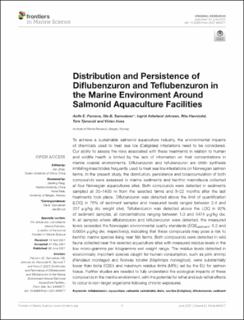| dc.contributor.author | Parsons, Aoife Elizabeth | |
| dc.contributor.author | Samuelsen, Ole Bent | |
| dc.contributor.author | Johnsen, Ingrid Askeland | |
| dc.contributor.author | Hannisdal, Rita | |
| dc.contributor.author | Tjensvoll, Tore | |
| dc.contributor.author | Husa, Vivian | |
| dc.date.accessioned | 2022-03-07T10:30:54Z | |
| dc.date.available | 2022-03-07T10:30:54Z | |
| dc.date.created | 2022-02-24T19:48:18Z | |
| dc.date.issued | 2021 | |
| dc.identifier.citation | Frontiers in Marine Science. 2021, 8 1-11. | en_US |
| dc.identifier.issn | 2296-7745 | |
| dc.identifier.uri | https://hdl.handle.net/11250/2983361 | |
| dc.description.abstract | To achieve a sustainable salmonid aquaculture industry, the environmental impacts of chemicals used to treat sea lice (Caligidae) infestations need to be considered. Our ability to assess the risks associated with these treatments in relation to human and wildlife health is limited by the lack of information on their concentrations in marine coastal environments. Diflubenzuron and teflubenzuron are chitin synthesis inhibiting insecticides frequently used to treat sea lice infestations on Norwegian salmon farms. In the present study, the distribution, persistence and bioaccumulation of both compounds were assessed in marine sediments and benthic macrofauna collected at four Norwegian aquacultures sites. Both compounds were detected in sediments sampled at 30–1400 m from the selected farms and 8–22 months after the last treatments took place. Diflubenzuron was detected above the limit of quantification (LOQ) in 76% of sediment samples and measured levels ranged between 2.4 and 257 μg/kg dry weight (dw). Teflubenzuron was detected above the LOQ in 92% of sediment samples, at concentrations ranging between 1.3 and 3474 μg/kg dw. In all samples where diflubenzuron and teflubenzuron were detected, the measured levels exceeded the Norwegian environmental quality standards (EQSsediment; 0.2 and 0.0004 μg/kg dw, respectively), indicating that these compounds may pose a risk to benthic marine species living near fish farms. Both compounds were detected in wild fauna collected near the selected aquaculture sites with measured residue levels in the low micro-gramme per kilogramme wet weight range. The residue levels detected in economically important species caught for human consumption, such as pink shrimp (Pandalus montagui) and Norway lobster (Nephrops norvegicus), were substantially lower than biota EQS’s and maximum residue limits (MRL) set by the EU for salmon tissue. Further studies are needed to fully understand the ecological impacts of these compounds in the marine environment, with the potential for lethal and sub-lethal effects to occur in non-target organisms following chronic exposures. | en_US |
| dc.language.iso | eng | en_US |
| dc.title | Distribution and Persistence of Diflubenzuron and Teflubenzuron in the Marine Environment Around Salmonid Aquaculture Facilities | en_US |
| dc.type | Peer reviewed | en_US |
| dc.type | Journal article | en_US |
| dc.description.version | publishedVersion | en_US |
| dc.source.pagenumber | 1-11 | en_US |
| dc.source.volume | 8 | en_US |
| dc.source.journal | Frontiers in Marine Science | en_US |
| dc.identifier.doi | 10.3389/fmars.2021.694577 | |
| dc.identifier.cristin | 2005331 | |
| dc.relation.project | Havforskningsinstituttet: 14907 | en_US |
| cristin.ispublished | true | |
| cristin.fulltext | original | |
| cristin.qualitycode | 1 | |
